VinØ 2022 - Annual Report
The VinØ ('vin zero') program is Tasmania's best management practice system, designed and tailored to assist the island's producers to monitor, improve, benchmark and communicate their viticultural and winery practices.
It is a significant and important initiative, providing user-friendly management and reporting tool. Program members each receive a detailed annual benchmarking report, which identifies areas of their business where they are performing well against best practices and areas requiring improvement. It also allows them to benchmark their performance against fellow program participants.
The VinØ Tasmanian Program aligns with the Australian Wine Industry Standard of Sustainable Practice - Viticulture and Winery and recognises formal accreditation programs (eg Sustainable Winegrowing Australia, Australian Certified Organics or Demeter Biodynamic). Tasmanian wine businesses which achieve certification under these programs are able to opt-out of also reporting their data through VinØ and are automatically recognised as having achieved best practice. As more Tasmanian wine businesses achieve formal certification and opt out of reporting their data, there has been a slight fall in the overall program score.
Below is the annual VinØ Program report for the 2021-22 season. This year sees the first program members qualify to use the VinØ logo in promotional material, through a minimum standard being achieved on every single question.
Wine Tasmania congratulates the 2022 VinØ Program Champion - Pooley Wines, and the 2022 VinØ Program Most Improved Producer - Barringwood!
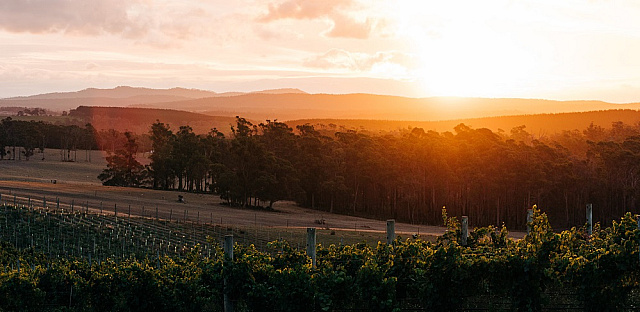
The data...
Just under half of Tasmania's vineyard area is managed under the VinØ Program, with 31 vineyards and wineries completing their online workbooks or participating in another recognised certified program
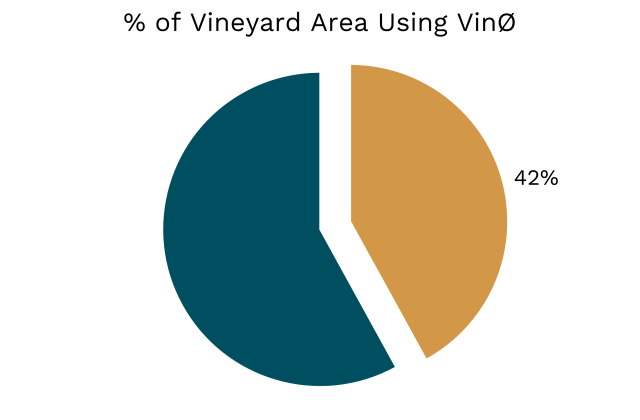
New wine producer members continue to join the VinØ Program
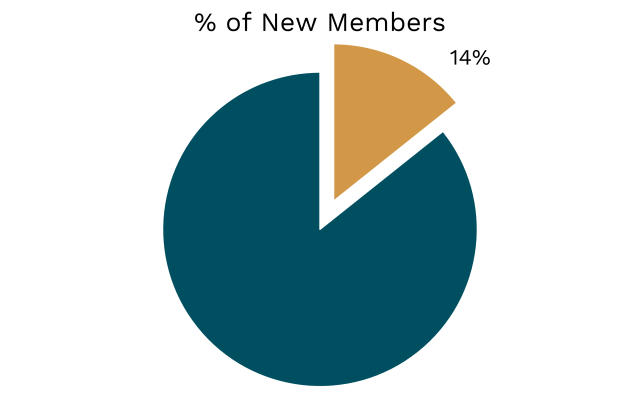
Program Member Results
This graph shows the proportion of program members' overall scores (members are scored on each of their metrics from "4 - excellent / best practice" to "0 - needs improvement"). There was a slight decline in the overall program results in 2021/22, reflecting new members beginning their program journey and some more experienced members opting out of completing the VinØ workbook and instead achieving formal accreditation through other programs.
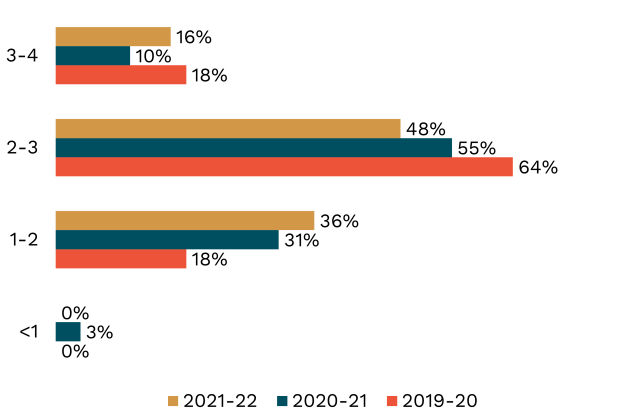
This season, the combined average score across members resulted was 2.23 out of a perfect mark of 4.
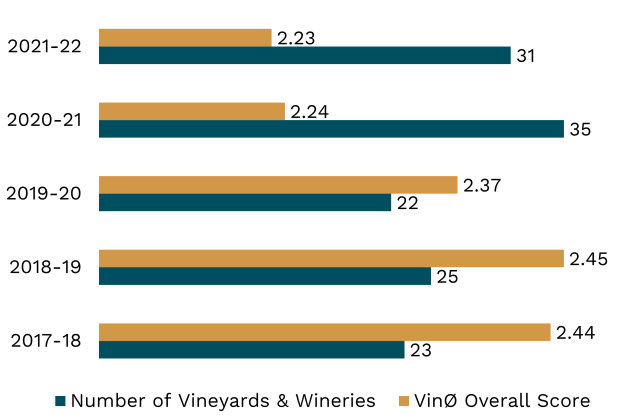
19% of members are certified under formal accredited systems, which are recognised by the VinØ program and Wine Tasmania
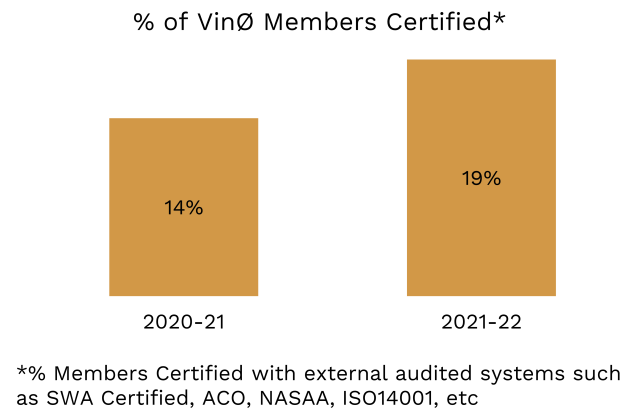

Module Results
The program is divided into nine modules:
1. Soil Health, Nutrition and Fertiliser Management
2. Pest and Disease Management
3. Biodiversity Management
4. Water Management
5. Waste Management
6. Social (Work, Community, and Winery Relations)
7. Biosecurity
8. Winery management
9. Carbon Emissions
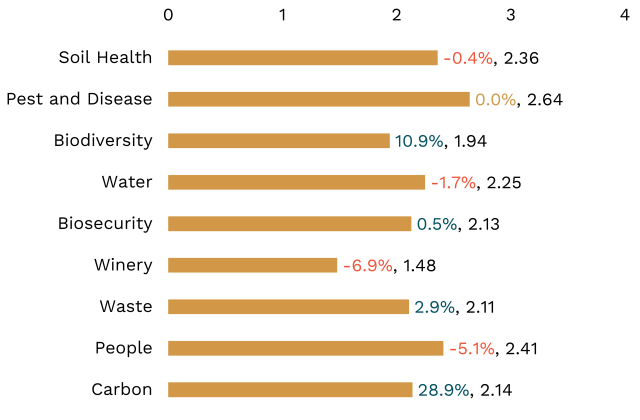

Areas in which Tasmanian wine producers are performing well:
| Soil Health - Weed Control Strategy |
| Pest and Disease - Grapevine Agrochemical Application Records |
| Water - Water Source |
| Biosecurity - Biosecurity Vineyard Inspections |
| People - Remuneration |
Areas showing an opportunity for improvement:
| Soil Health - Organic Matter |
| Biodiversity - Site Audit; Biodiversity Action Plan |
| Water - Water Management Strategy; Infiltration and Over Watering; Irrigation Records; Over Watering |
| Biosecurity - Training and Induction; Property Entry; Personnel Disinfestation |
| Winery - Winery Property Map; Environmental Action Planning; Soil Around the Winery; Emergency Spill Response; Winery Water Management Program; Winery Wastewater Management; Biodiversity Plan - Winery Site; Air; Fuel |
| Waste - Waste Management Planning, Monitoring and Recording; Waste Management Training; Composting |
| People - Record Keeping for the Purchasing Winery |
2022 Member List
| Barringwood | Logo Standard Achieved | |
| Brown Family Wine Group | Logo Standard Achieved | External Certification |
| Cape Bernier | ||
| Clover Hill | ||
| Dalness Farming | ||
| Delamere Vineyard | ||
| Derwent Estate | ||
| Gala Estates | ||
| Hill Smith Family Vineyards | Logo Standard Achieved | External Certification |
| Holm Oak Vineyards | ||
| Invercarron Wines | ||
| Josef Chromy Wines | ||
| Kate Hill Wines | ||
| Marion's Vineyard | Logo Standard Achieved | External Certification |
| Meadowbank | ||
| Merriworth | ||
| Moores Hill | ||
| Moorilla Estate | ||
| Nocton | ||
| Pooley Wines | ||
| Puddleduck Vineyard | ||
| Quiet Mutiny | ||
| Riversdale Estate | ||
| Small Wonder Wines | Logo Standard Achieved | External Certification |
| Southwood Wines | ||
| Stargazer Wines | ||
| Stoney Rise | ||
| Swinging Gate Wines | ||
| Tasmanian Organic Wines | Logo Standard Achieved | External Certification |
| Tertini Wines | ||
| The Ridge North Lilydale | ||
| Waterton Hall | Logo Standard Achieved | |
| Webster Ltd | ||
| Westella Vineyard | ||
| White Rock |
Wine Tasmania acknowledges the Aboriginal people as the traditional owners of lutruwita (Tasmania), our island home. We pay our respects to the Tasmanian Aboriginal community, their Elders past, present and emerging, their unique cultural and spiritual relationships to the land, water and community.

